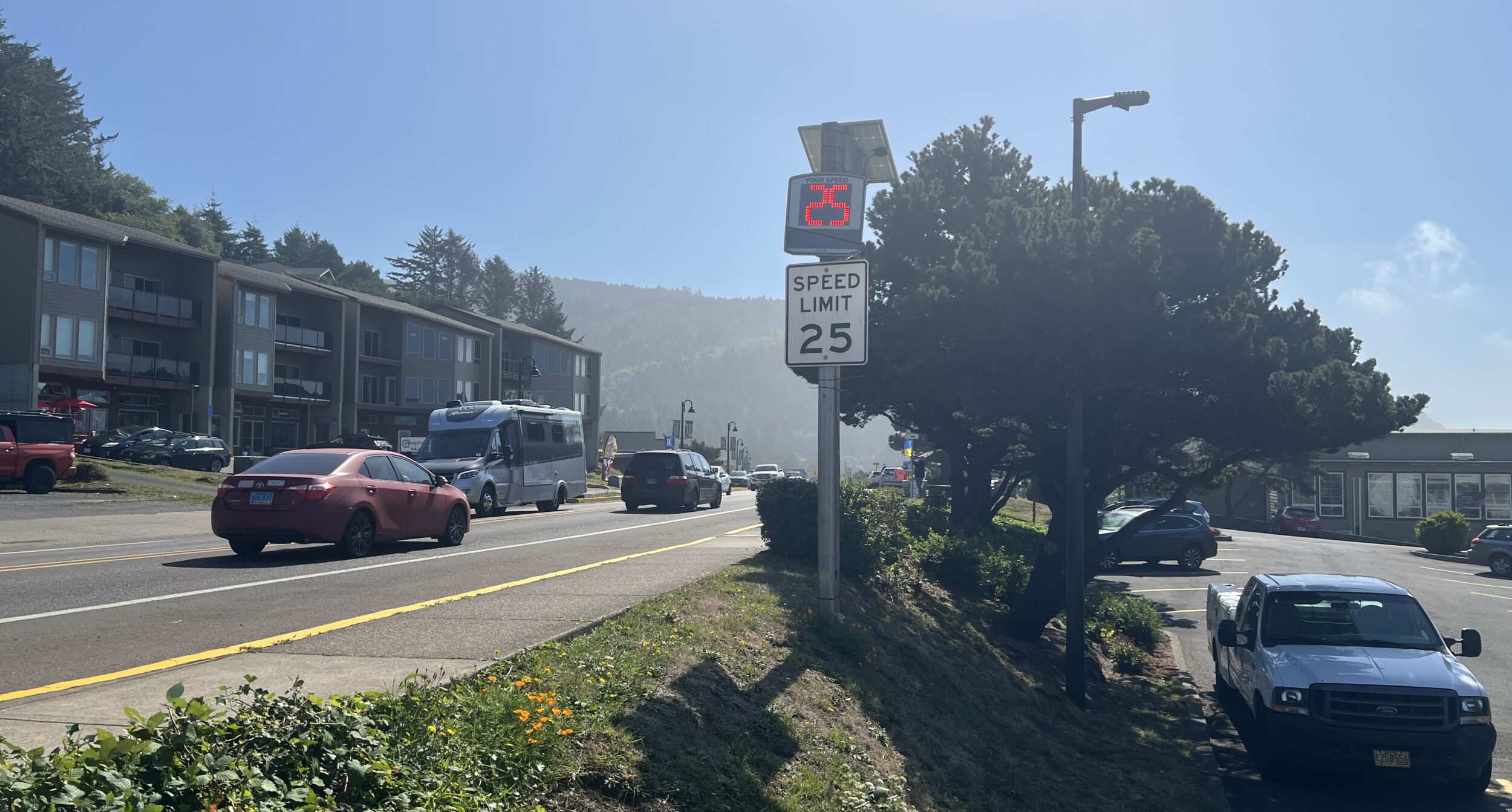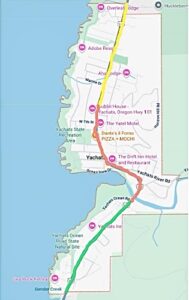
By GARRET JAROS/Lincoln Chronicle
YACHATS — Speed limits along U.S. Highway 101 on the outer edges of Yachats will be dropping in the coming months. But not by much. And studies suggest the effect it will have on motorists speeding through town is likely to be negligible.
City officials and members of the Public Works & Streets Commission have been pressing the Oregon Department of Transportation to lower the current 40 mph speed zones on the north and south ends of town to 25 mph.
After completing a three-year study, ODOT came back to the city in mid-April to say the speed zones would remain unchanged. The study suggested the city could mitigate speeds by extending sidewalks and planting trees along the highway to subtly signal to drivers they should slow down.
The city appealed the decision to the agency’s speed zone review panel, which met Wednesday, and after hearing presentations by ODOT and city officials, ruled the 40 mph zones be lowered to 35 mph.
But during deliberations one panel member noted a five-mile-an-hour change will have almost no effect on traffic speed. In fact, he said, experience elsewhere shows if speeds are lowered by five miles an hour there is about a one mile an hour change in behavior.
Despite the small change to the 40 mph zones, the city did score a slight win with the panel’s direction that ODOT work with city officials “to review the transition points between 55, 35 and 25 mph” based on development along the highway and road use. One panel member described it as “fine tuning” where the breaks between the three speed zones should be located.
City manager Bobbi Price wrote in an email to the Lincoln Chronicle that she was optimistic about the panel’s decision.
“The city of Yachats is pleased with the recent approval from ODOT for a change in speed zones,” she said. “The reduction from 40 mph to 35 mph will enhance safety by slowing down traffic as it enters town. Additionally, extending the 25 mph zone will further help to calm traffic as drivers approach the city center.”
She also said the city has purchased a mobile speed radar trailer that will be strategically placed to provide real-time feedback reminding drivers to slow down before reaching the heart of Yachats.
ODOT speed study
While the speed zone panel is under the auspices of ODOT, its five members are comprised of representatives from the Governor’s Transportation Safety Committee, Oregon State Police, the Association of Oregon Counties, the League of Oregon Cities, and ODOT.

Its purpose is to conduct hearings to decide contested speed zone recommendations while also acting as an advisory body to ODOT. Wednesday’s hearing began with ODOT officials presenting the results of its speed study, followed by a presentation by Public Works & Streets Commission member Don Phipps.
The ODOT study looked separately at traffic patterns in the 40 mph speed zones to the north and south of the 25 mph posted zone, said Angela Kargel, the agency’s state traffic engineer and authority for setting speed zones in Oregon.
The study focused on data collected during the month of April between slower winter traffic and busier summer travel.
The north section from just north of Overleaf Lodge Lane to Ninth Street, saw an average of 5,200 vehicles per day and that 85 percent of vehicles were traveling at or below 49 mph. Some 50 percent of vehicles — which the panel gives more weight in its decision making – were clocked at 43 mph.
Seventy-one percent of vehicles exceeded the 40 mph speed limit and 68 percent of vehicles were between 38 and 47 mph. There were three crashes during the study period between 2020 and 2022, with no serious injuries.
As a result of the investigation ODOT recommended keeping the existing 40 mph section, Kargel said. But she said ODOT agreed to extend the 40 mph zone north of the fire station after a fatal collision in 2024 involving an ambulance.
The south section of Highway 101 begins 200 feet south of the Yachats River bridge and ends 250 feet south of Windy Way. It has an average of 3,600 vehicles per day and 85 percent of speeds matched the north section at 49 mph, as did the 50 percent at 43 mph. However, 83 percent of vehicles exceeded the speed limit, and 75 percent traveled between 39 and 48 mph. There was one crash resulting in no serious injuries. ODOT again recommended no change in the speed limit.
Yachats presentation
In delivering Yachats’ presentation, Phipps presented a blizzard of information that questioned ODOT’s methods for collecting its speed data while also saying the agency did not comply with its own regulations.
The panel later dismissed those assessments.
Phipps said decreasing the 40 mph zones to 25 mph would increase pedestrian safety when crossing and walking along the highway and that it would be a minimal inconvenience to motorists – adding just 81 seconds to travel time through the community.
Phipps also asked the panel to consider Yachats residents’ median age of nearly 64 years. He cited studies showing that pedestrians 65 and older represent the age group with the highest number of fatalities and injuries in roadside accidents.
One example was a 75-year-old Yachats man who was struck and killed in 2013 at 4 p.m. while trying to cross the highway near his home in the 40 mph stretch north of town.
“The city of Yachats believes that common sense would suggest that slowing the traffic on (the highway) through the city would increase the safety of crossing the highway for our seniors,” Phipps said.
The city’s report concluded that ODOT’s study was “deficient” and failed to comply with standard methods of determining urban speed zones and failed to recognize the danger faced by pedestrians and bicyclists both along the highway and while crossing the highway, and the danger for residents when pulling onto the highway from residential streets and driveways.
Price, who also attended the online hearing, added that extending the 25-mph zone north would be a great benefit to those crossing the highway to access the 804 Trail.
Panel deliberations
There is a debate whether posting different speeds results in drivers altering their speeds or whether it is tied more to the context of what they see around them – whether more rural and open or residential and busy, said panel member Mark Barrett.
“I think ODOT’s methodology generally points to drivers are less responsive to whatever the sign says and more responsive to the context around them,” he said. “… I don’t see that reducing the speed limit to 25 is going to result in compliance with a 25.”
Panel member Stacy Shetler said both ODOT’s and the city’s information revealed that people are not following the speed limit no matter what is posted. And he agreed with panel members that drivers do not consider the travel time when choosing their speed so much as the context of what is around the road.
Panelists all agreed that the nature of Yachats traffic is unique because of its recreation destination status and not something they are used to dealing with. Yachats has both local traffic and motorists in all sorts of vehicles just passing through.
Brian Barnett, appointed to the panel by the League of Oregon Cities, said he was confident in ODOT’s determination and that they were following established guidelines.
A big concern in reposting the speed zones to 25 mph is that while some locals may stay within those limits and given that most drivers are wanting to go 45 mph “… we’re really going to be seeing the potential for unsafe passing occurring on this roadway,” Barnett said. “And that presents a whole new set of problems.”
Barnett added that he is always mindful of the rule of unintended consequences in any of the panel’s decisions.
“So this is a sticky wicket,” he said. “I acknowledge that readily. I can say with certainty that I’m very uncomfortable with the actual safety outcome of posting at 25.”
In the end, the panel agreed to 35 mph because of the “context” of the area and the unique challenges Yachats faces as both a travel destination and thoroughfare for local motorists and others headed to different locations.
“I’m also thinking that we would remand it back to ODOT to decide where the limits of where these speed areas would actually be, based on conversations with the city,” Barnett concluded.
- Garret Jaros covers the communities of Yachats, Waldport, south Lincoln County and natural resources issues for Lincoln Chronicle and can be reached at GJaros@YachatsNews.com




















Has there been any enforcement such as fining speeders? That seems like a logical place to begin. Or simply parking a law enforcement vehicle with a ‘dummy/mannequin’ inside seems to help … for awhile.
Don Phipps of the Public Works and Streets Commission has also researched speed cameras, which in addition to fining speeders bring revenue to the city. Brian Barnett’s remarks that speed limits don’t work because drivers ignore them confirm the need for speed cameras and automatic fines.
Thank you, Don. Keep up the good work.
My perception is that traffic between Newport and Yachats needs better regulation overall. I’d imagine it’s similar between Newport and Depoe Bay. At the extreme ends have the 40mph drivers and the risk takers both of whom have an oversized effect on the flow of traffic. There’s so much new development being approved along the corridor between these segments, creating additional direct 101 access for individual homes. I’m not sure if the County is doing any planning to reduce the number of access and egress points being added but I hope that limiting those points is a priority.
How does ODOT consider traffic on 101 within closely connected communities?
Progress is slow sometimes. Waldport has the same problems with speeders. Rumor has it they are working with ODOT on new speed radar signing.
ugh … radar, cameras, auto ticketing devices taking pictures of our cars? Come on folks.
This wouldn’t have to be done is people stopped speeding in the towns and cities. So many near misses in downtown Depoe Bay because people just don’t understand that 25 miles per hour means 25 miles per hour. Follow the rules then you don’t have to worry about radar, cameras and auto ticketing devices. I know I won’t because I don’t speed through towns and cities.
Even though the panel did not agree to Don’s recommendations to lower the speed limit to 25 MPH throughout the city, they did leave the door open for the city and ODOT to negotiate the two 35 to 25 transition points. My assumption is Bobbi Price and Rick McClung will be involved in the negotiation as well as Don Phipps and the PW Commission. I recommend that in the southern section identified by Don as section ‘C’ that the transition from 35 to 25 occur at the southern end of the bridge. Further, I recommend that in the northern section identified by Don as section ‘A’ that the transition be located immediately north of Earthworks Gallery/Beach Daisy Wine. I realize this is a stretch to expect ODOT to agree but those two transition locations would encompass the current city pedestrian and cross traffic areas in my opinion.
Working with ODOT to make pedestrians and bicyclists safer within Yachats is commendable. Highway 101 is under ODOT’s purview. Unfortunately along the central Oregon Coast Yachats, like other small cities, we have Highway 101 as our “Main Street”.
I agree with ODOT that extending sidewalks and replanting the trees along 101 would go a much further way towards increasing the safety the city is trying to develop. Working with ODOT to extend parking and sidewalks north would make a big difference, both for safety as well as helping to create a more productive and inviting “Main Street”. Any development along 101 should be required to add sidewalks and on street parking, similar to Aqua Vista Square. The only fatality I am aware of here was a man hit by a car at night and killed when he was walking along 101, no sidewalk, near Marine Drive.
Speed limits on signs are not what change driver’s behavior; the design of the street does. Studies show that streets with trees, colorful crosswalks, parked cars on narrowed roadways, altering turn radius and curb extensions slow drivers. Having pedestrians, parked cars and other visuals sends a message to drivers that they are visitors and not owners within the area and need to slow down to be safe.
People walking on streets is not dangerous; people walking on streets designed for cars to drive fast is.
Yes, this makes sense. Drivers do respond to context more than they do to signs. The idea of ticketing a driver after the fact of speeding is reactionary — it punishes behavior after the fact. How does that help in the present, when they’re driving through town? Making streets safer through intelligently designed environmental features is proactive, meaning it will affect their driving in real time, not two weeks after the fact when they find a ticket or summons in their mailbox. All the flashing “gotcha” cameras do is make fuming drivers not want to return. That’s not sensible for a tiny city that relies upon visitors.
After returning from a trip The Netherlands where I drove a rental car, I received significant charges from the rental car company for exceeding the speed limit by as little as 4 km/hr on several occasions, recorded by roadside sensors.
the 73 year old man killed in 2013 on the north edge of Yachats was not killed due to high speed, but rather by a young driver passing a left-turning signaling car on the right, failing to see him crossing the road in front of the turning car.
Thank you for the clarification.
That points to the need for road design improvements such as sidewalks and on-street parking. Speed isn’t the only issue here.
The southbound traffic after the Yachats River is dangerous and a noise nuisance. It’s also stupid to allow increased speed going into a stretch of winding road with posted speeds of 25/30. Essentially what happens is speed demons get an all-clear from 25mph to 40mph, but actually gun it up to 50/60mph for a quarter mile, only to have to slow down. Just keep it 25, and install a traffic camera to fine violators — it’s passive income for the city.